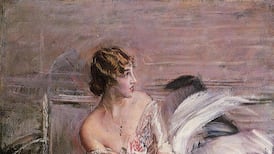The Round Room of the Mansion House in Dublin is a monument to a round monarch. Now 200 years old and the site of a commemorative exhibition, it was built expressly to host a banquet for the famously corpulent King George IV when he visited Ireland in August 1821, escaping his wife and other problems at home.
His reputation for high living preceded him, although not to the extent that the carriage sent to meet him at Howth – where he arrived already drunk – was big enough.
It was a struggle to close the door after he got in. Despite this, his visit to Dublin was a roaring success. “My heart has always been Irish,” he declared and seemed to mean it.
The death of his wife just days before probably helped. Caroline of Brunswick had also been his first cousin but their marriage in 1795 was an expedient arranged by George’s father. For both partners, it had been hate at first sight, or nearly.
One problem was that she didn’t wash very often. Another was that the then prince had married already, in secret, except his wife was a Catholic and the king had not approved, so it didn’t officially count.
In any case, soon after the new couple somehow created a daughter together (she thereby became her own second cousin), they had pursued separate lives and many extramarital affairs. Then the prince became king in 1820, whereupon Caroline decided she wanted to be queen.
Instead, she was locked out of his coronation on July 19th, 1821 and after failed attempts to gatecrash Westminster Abbey went home and fell ill. When she died three weeks later, even as the new monarch was heading for Dublin, many (including her, while she still could) suspected poison.
Against this background, the king's revels here were satirised in England as an "Irish wake". In the meantime, Dublin had gained a remarkable new building, and in extraordinarily quick time. By some accounts, it was constructed in six weeks. By his own account (in a letter to The Irish Times decades later) the architect John Semple said it had been done in three weeks. Either way, the speed was facilitated by a shortcut involving the roof.
The room had been designed to evoke “a Moorish palace open to the sky”. Irish weather not being Moorish, however, the ceiling was instead painted to suggest a sky (although much modified since, the room now is still overlooked by a starry night effect). But the first roof was only a temporary one: the real thing was not added until 1824.
The contrast between the Augusts of 1821 and 1921 in the Round Room could hardly have been more dramatic. On the centenary of the royal banquet, the venue hosted the inaugural meeting of the second Dáil, held in the wake of the War of Independence and about to make the compromises that would lead to a civil war and the Free State’s troubled birth.
One thing that had changed little was the peripheral role of women in public life. They had not been seated at the 1821 banquet (although welcome to watch the diners from the balcony), and a century later were still only edging their way into Irish politics.
This is reflected by an eccentric feature of the current exhibition, whereby guests enter the main space via the ladies toilets, eavesdropping on a semi-secret meeting held there in 1917 by Countess Markievicz, Rosamond Jacob, Kathleen Lynn and other daughters of the revolution.
The script is a bit clunky and so are the voiceovers, but as a square bathroom scene in a round room, it makes its awkward point.
Elsewhere, everything is circular or curved, including the arrows that point you in and out of the exhibits. Those also touch on the mid-19th century glories of the Lord Mayor's Ball, the epic 20th-century reign as mayor of Alfie Byrne, and such extraordinary spectacles as the Irish Hospitals Sweepstake, first drawn from round drums in the Round Room in 1939.
The sense of circularity does not end with the architecture and exhibits. People emerging from lockdown to visit this show (roundroom200.com) may also hope to take advantage of the many bars and restaurants now reopening in and off Dawson Street, availability of staff allowing.
This is not a new problem locally. Although he enjoyed a building specially erected for the purpose, George IV was less pampered during the actual dinner in 1821. Due to a shortage of waiters, the lord mayor had to serve the king’s soup, while the monarch himself then had to do likewise for the lord lieutenant.












